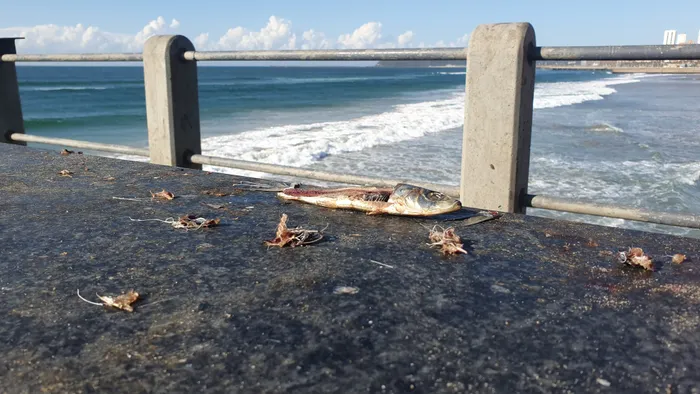Call to increase shad bag limit: ‘For us to be limited in what we catch is a bit unreasonable’

The Oceanographic Research Institute in KwaZulu-Natal says that the regulation is in place to protect the species An old sardine on the bait cutting table provided for fisherfolk at the Durban beach front pier. Pictures: Jehran Naidoo/Independent Newspapers
THE bag limit of four Shad during open season has been labelled as unfair, unrealistic and outdated by fisherfolk in Durban.
However, the Oceanographic Research Institute (ORI) in KwaZulu-Natal, says that the regulation is in place to protect the species.
The stringent regulations around Shad in KZN date back to the 1970s when the government and scientists observed a decline in fish stock, said ORI’s Dr Sean Fennessy.
The current bag limit remains at four Shad, at a minimum of 30cm each in length.
The same limit applies for boat, rock and surf fisherfolk.
But while this limit may be reasonable for recreational fishing, it is unrealistic for subsistence fisherfolk, says John Peter Narainsamy from the KZN Subsistence Fishing Forum.
“It was around the late 1960s and early 1970s that the government decided to introduce a closed and open season to fish Shad, along with the bag limit which was initially five. After much discussion, that was eventually changed to four Shad to accommodate a longer open season.
“When it comes to subsistence fisherfolk, people who live off their catch, four shad is not enough. That limit was set a long time ago and it has not been revisited. If we take into account the cost of living today, transport and fuel, four Shad, realistically, cannot even feed a family of four.
“This is not a deep water fish like tuna or barracuda, they are very much like sardines in that they migrate here from the Western Cape and spawn in our waters. A female shad can lay up to 2 million eggs at a time, so we feel the bag limit needs to be revised. We can’t understand how the government does not have a problem with fishing trawlers but restricts fisherfolk,” said Narainsamy.
However, Fennessy said the fishing trawlers that traverse KZN waters do not catch any shad or other reef fish but mainly orange crab and other deep water species.
Fennessy said the rationale around the limitations around catching shad derived from predictive models that looked at the size of the fish, the amount of fisherfolk and what season of the year it was, among other biological factors.
He added that the regulations were not enforced to the degree that they should be.

“The story of trawlers stealing people’s fish is not true. Trawlers do not fish for shad. They are around 20 to 30 kilometres off shore looking for the large crabs and other deep water fish. When it comes to the limit of four shad, that is the same for boats as they are for rock and surf fishermen but the problem we find is that monitoring and enforcing these bylaws does not happen the way it should be.
“The entire argument around shad has been going back decades. Our department conducted extensive research into the migratory and spawning patterns of these fish, among other things, to try and determine a proper fishing limit.
“What the science determined was an offtake or catch number. The model showed that if we want to reduce the bag limit, then we have to increase the amount of months where people are allowed to catch shad. We do all of this only to protect the stocks of fish and ensure continuation,” Fennessy said.
Speaking from the Snake Park Pier, on the Durban Beachfront, Derrin Maclou from Newlands, said the Shad bag limit was not feasible for him to put food on the table when he did not have “work available”.

“I’ve been fishing all my life. It puts food on the table when I’m out of work or there’s no shutdown happening. Just to buy bait and pay for transport to the pier is costly. For us to be limited in what we catch is a bit unreasonable. I think around 7 to 10 is okay,” Maclou said.
eThekwini Municipality spokesperson Gugu Sisilana confirmed the regulations around catch size and bag limit.
“Possessing more than the allowed number of shad fish or having shad fish that are less than 30cm in length is a punishable offence,” Sisilana said.
Meanwhile, Narainsamy and Chatsworth fishermen Ivan Pillay said fisherman also needed to clean up after themselves on the beaches and piers.
“From sharp hooks lying in the sand, to rotting bait on the shore, fisherfolk with no regard or concern for public hygiene give everyone a bad reputation,” Pillay said.
“It will cost people nothing to carry a packet with them when they leave home to fish. To see the state of our beaches in the morning after fishermen leave the beach overnight is truly disgusting. You will find alcohol bottles, plastic chips packets and bait boxes,” Pillay said.
Narainsamy said he did not blame the municipality for being so strict with fisherfolk when it came to using the Durban piers.
“Durban is a tourist destination and sometimes people, like the fisherman, forget this. Sadly, they only think about themselves and how much they can catch. There are boards on the pier to cut bait but we still find people cutting it on the concrete floor and leaving behind blood stains. That is unacceptable,” Narainsamy said.
Sisilana said that bait, bottles, fishing lines, hooks, and paper/plastic items were some of the common items left behind by fisherfolk.
“Fishermen are requested to fish only at the designated piers. Cleaning fish at the pier is not allowed. Baits and plastics should be disposed of in the refuse bins strategically located on the piers,” she said.
Related Topics: